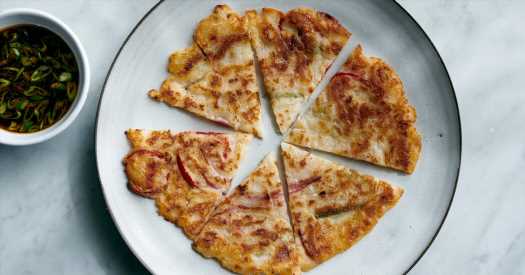A Foolproof Path to Dinner, by Way of Korea

I wonder how long this has been here, I thought to myself as I opened a forgotten jar of sauerkraut I’d left fermenting in the back of the fridge, now so effervescent that it hissed and bubbled as I loosened the lid.
As a recipe developer, I often find myself with odds and ends in the fridge. In the past, I’ve maintained that hash or perhaps frittatas are the best way to make use of them, but recently I’ve been turning toward jeon (Korean pancakes). Not only are they fast, they are staggeringly versatile as well, making use of virtually any vegetable, seafood or meat, and bound with any type of flour.
They can be wheat-flour pancakes stuffed with squid, oysters and scallions (haemul pajeon), or thick, crunchy mung bean-and-pork nokdu jeon, traditionally served at Lunar New Year. They can be an orderly forest of dark-green wild onions bound together with a thin egg batter, as in Busan’s famous Dongnae pajeon, or thin kimchi jeon flavored with spicy fermented napa cabbage and gochugaru (Korean chile flakes).
The best jeon I’ve ever had were at Hooni Kim’s New York restaurant Hanjan, where he shallow-fried scallions, ramps, chives and squid, barely coated in a thin batter made with cornstarch, flour, egg yolk, baking powder and soda water. As he flipped and transferred the pancakes to a deep fryer, they’d puff, moving the simple pancakes into the third dimensional. A simple pan-fried version of that recipe shows up in his wonderful cookbook “My Korea,” but jeon can be even simpler still.
For the most basic, all you need is flour, cold water and a mix-in or two, and, within 10 minutes of rummaging through the crisper, you’ve got yourself an after-school snack, a light lunch or a landing pad at the base of your stomach for a night of drinking makgeolli (unfiltered Korean rice wine). Made this way, the pancakes have a texture that’s crispy and mildly chewy, thin but dense. But because jeon are so quick, foolproof, adaptable and inexpensive, they are ripe for experimentation. I encourage you to start with a simple batter and see what happens when you add or alter the ratio of ingredients.
In my testing, I’ve found that swapping some flour for starch (such as corn, potato or tapioca) will make your pancakes a little lighter and crisper. (I like a ratio of around three parts wheat flour to one part cornstarch, though I never use exact measurements for jeon.) Egg whites will cause them to puff and rise as they fry, for a texture somewhere between an omelet and a thick crepe, while egg yolks will tenderize them. The bubbles of carbon dioxide added by using soda water in place of still water, or by adding a touch of baking powder (or both!) will give you a pancake with lacier edges and puffy internal texture.
For mix-ins, everything should be sliced thin enough to cook through in the few minutes it takes to cook each pancake. In general, jeon have a much higher ratio of star ingredient to batter than Western-style pancakes, so feel free to load up that batter with as many vegetables or bits of meat and seafood as you’d like.
Whatever extra ingredients you add, there are two cardinal rules: The water must be cold (even ice cold, if you want to be exacting), and mixing should be minimal. Both of these steps ensure you don’t form too much gluten, which will lead to tough, leaden pancakes.
It was actually that overfermented sauerkraut that got me on a pancake-making bender in the first place: In my years of cooking, I have yet to come across a sauerkraut recipe that isn’t delicious when made with kimchi, and vice versa. (If you’ve ever had a deep-fried pickle chip, you’re well aware that pickled and fermented ingredients are wonderful when paired with fried batter.) Kimchi alone also makes a fine pancake, though I enjoy the umami punch that briefly sautéed shiitake mushrooms add to them.
For watery vegetables, such as zucchini, salting and squeezing them will help retain some crunch. (And don’t toss the liquid that comes out: Use it as the base for your pancake batter.)
As my wife, Adri, can attest, I solved our “what do we do with these random vegetables?” problem virtually overnight, supplanting it with the marginally better “how are we going to eat this many pancakes?” problem.
Recipe: Sauerkraut Jeon (Korean Pancakes)
Follow NYT Food on Twitter and NYT Cooking on Instagram, Facebook, YouTube and Pinterest. Get regular updates from NYT Cooking, with recipe suggestions, cooking tips and shopping advice.
Source: Read Full Article

